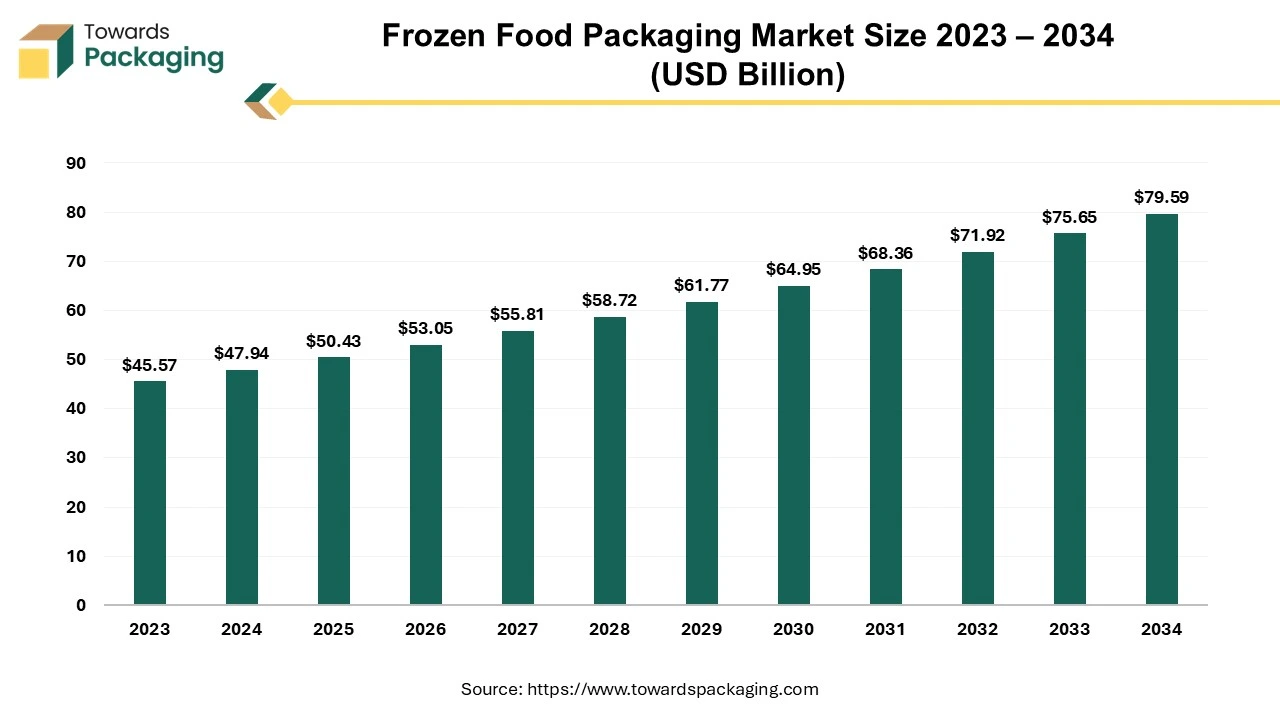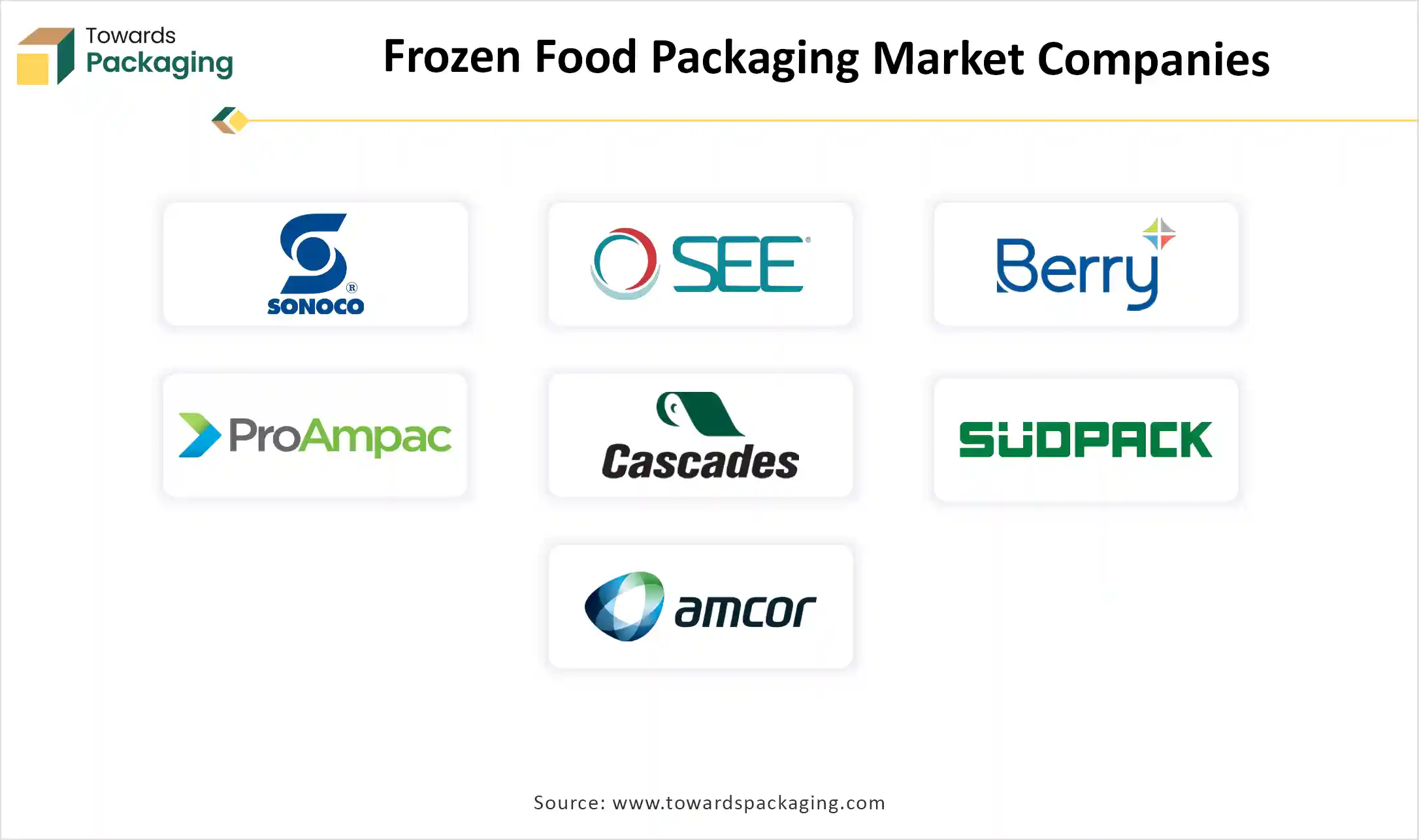November 2025
The frozen food packaging market reached USD 47.94 billion in 2024 and is projected to hit USD 79.59 billion by 2034, expanding at a CAGR of 5.2%. The report provides comprehensive segmentation by material (plastic, paperboard, metal), type (bags & pouches, trays, films, boxes), and application (meat, dairy, bakery, fruits & vegetables). It covers detailed regional data across North America, Europe, Asia Pacific, Latin America, and MEA, highlighting North America’s 2024 dominance and Asia Pacific’s fastest growth trajectory. The report includes an in-depth competitive landscape featuring Sonoco, Sealed Air, Berry Global, Amcor, and ProAmpac, along with value chain and trade flow analysis, import–export statistics, and supplier/manufacturer data across key regions.

The specialized packaging materials and designs that protect food products stored at sub-zero temperatures (-18 degree Celsius) is known as frozen food packaging. It ensures food safety, freshness, extended shelf life by preventing moisture loss, freezer burn, and contamination. The frozen food packaging is temperature resistant, moisture resistant and vapour barrier. Different types of material utilized for manufacturing frozen food packaging have been mentioned here as follows: aluminium foil, plastic films, paperboard & cardboard, vacuum, and clamshell containers and rigid trays.
| Metric | Details |
| Market Size in 2024 | USD 47.94 Billion |
| Projected Market Size in 2034 | USD 79.59 Billion |
| CAGR (2025 - 2034) | 5.2% |
| Leading Region | North America |
| Market Segmentation | By Material, By Type, By Application and By Region |
| Top Key Players | Sonoco Products Company, Sealed Air, Berry Global Inc., ProAmpac, Cascades Inc. |
The projection of various government laws for protecting the environment from harsh chemical packaging has increased demand for the frozen food packaging. Regulations on plastic waste & carbon footprint reduction push companies toward biodegradable & recyclable packaging solutions. The utilization of molded fiber trays, compostable films and recyclable paper-based packaging is increasing. Brands are shifting to mono-material packaging (E.G., 100% recyclable polyethylene films) for easier recycling.
Innovations in high-barrier films & multilayer flexible improve moisture and oxygen resistance. Vacuum-sealed and MAP-modified atmosphere packaging for frozen food packaging assists to extend shelf life by preventing oxidation and ice crystal formation. The innovation of nano-coating and bio-based barrier films are being introduced for better food protection.
The introduction of QR codes, RFID tags, and NFC-enabled packaging provide real-time tracking, freshness indicators, and cooking instructions. Color-changing indicators that detect temperature fluctuations help to maintain food safety. Augmented reality (AR) & interactive packaging improve consumer engagement.
The flexible stand-up pouches & resealable zipper bags enhance convenience and reduce waste. The introduction of microwave-friendly packaging (ovenable trays, steam-release pouches) caters to the growing ready-to-eat meal market. Dual–compartment packaging separated components (e.g., sauces & main dishes for better quality retention.
Growth of direct-to-consumer meal kits and frozen grocery deliveries is rising need for insulated, shock-resistant, and temperature-controlled packaging. Gel packs, dry ice packaging, and vacuum insulation panels (VIPs) are being utilized to maintain frozen temperatures during transit.
Increasing demand for vegan, gluten-free, and organic frozen foods is driving innovation in sustainable packaging. Plant based fibers are being used widely for frozen food packaging. Premium frozen products require high-quality packaging that ensure freshness and prevents contamination.
The integration of artificial intelligence in frozen food packaging improves sustainability, quality control and food safety. Internet of Things & AI-powered sensors track temperature, humidity, and product freshness in real-time. The addition of smart labels & RFID tags to the frozen food packaging which change color or trigger alerts if the package experiences temperature fluctuations or damage. The AI-enabled blockchain technology enables authenticity and traceability, preventing frauds and food contamination. The machine learning and computer vision identify defects like misalignment, leaks, and improper sealing. AI-driven automation enables consistency in packaging weight, labeling and durability. The AI-integration reduces food waste by eliminating faulty packages before distribution.
The integration of artificial intelligence uses predictive modeling to help manufacturers to develop lightweight, recyclable packaging without compromising durability. AI analyzes material strength and barrier properties, optimizing packaging for freezer conditions. Eco-friendly alternatives (bioplastics, molded fiber, and paper-based wraps) are developed based on AI simulations. AI-driven predictive analytics forecast best storage conditions, reducing energy consumption. Route optimization algorithms ensure frozen food is transported efficiently, reducing spoilage risks. AI-powered warehouse management prevents overstocking, understocking, and expiration-related losses.
Due to the busy-life style and acceptance of modernization the online grocery purchasing culture is flourishing. Rise of online food retail platforms (Blinkit, Instamart, Amazon Fresh, Zepto, Instacart, etc.) is increasing the demand for durable, insulated, leak-proof packaging. Direct-to-Consumer (DTC) meal delivery services require advanced frozen food packaging solutions to maintain freshness during transit.
However, Amazon's warehouses and logistics network give it the advantage of being able to stock more SKUs and shelf-stable categories where variety is most important, like snacks and hot beverages. Due to the tremendous demand during the pandemic, large offline grocery merchants expanded their online ordering facilities, particularly for click-and-collect, for food and drink products.
The key players operating in the market are facing issues due to stringent government regulations, compliance issues, and environmental concerns, which has estimated to restraint the growth of the frozen food packaging market in the near future. Strict food safety and packaging regulations (EU, FDA, FSSAI) require frozen food packaging to meet specific material and labeling standards.
Rapid urbanization has risen the demand for the ready-to-eat foods, snacks, and frozen meals. Growth in dual-income households & single-person living is boosting demand for portion-controlled frozen food packaging. Hence, rising consumption of ready-to-cook items has created lucrative opportunity for the growth of the frozen food packaging market in the near future.
The plastic segment held a dominant presence in the frozen food packaging market in 2024. Plastic material is extensively used for frozen food packaging as it is durable, contains barrier properties, flexible, light-in-weight, and inexpensive. Plastic remains intact and does not break easily under freezing temperatures, unlike glass or some brittle materials. Many plastics, like polyethylene (PE) and polypropylene (PP), offer good moisture and oxygen barriers, preserving food quality and preventing freezer burn.
Plastic material packaging reduces shipment cost as it is lightweight and can be molded into various shapes and sizes for convenience. Plastic materials can be easily heat-sealed, enabling airtight packaging to maintain food freshness. Plastics utilized in frozen food packaging resist moisture, oils and other food components, preventing contamination or degradation. Newer biodegradable and recyclable plastics are being developed to minimize environmental impact while maintaining the benefits of traditional plastics.
The bags and pouches segment accounted for a considerable share of the frozen food packaging market in 2024. The bags and pouches used widely for frozen food packaging due to its flexible nature and lightweight. The flexible packaging pouches and bags conform to the shape of the food, maximizing storage efficiency in freezers. Flexible packaging bags & pouches require less material than rigid packaging, minimizing production, transportation, and storage costs. Multi-layer plastic films offer strong resistance against oxygen, moisture, freezer burn, preserving food quality.
Many frozen food bags come with heat-sealable or resealable zippers, maintaining freshness and convenience. Pouches and bags are type of flexible packaging allows for high-quality printing, labeling and branding with attractive designs to catch consumer attention. Many frozen food pouches have been manufactured with recyclable or biodegradable materials to minimize environmental impact. The pouches and bags are suitable for a wide range of frozen products, including vegetables, meats, seafood, and ready-to-eat meals.
The meat, poultry & seafood segment registered its dominance over the global frozen food packaging market in 2024. Freezing prevents bacterial growth spoilage, and contamination in perishable protein like seafood and meat. Packaging acts as a barrier against oxidation and moisture loss, maintaining texture, flavor, and nutritional quality, High-quality plastic films create an airtight seal, preventing the dehydration and freezer burn, which can affect taste and texture.
The frozen food packaging is mostly used for packaging meat, poultry and seafood so that the shelf-life is extended. It allows for global distribution of meat and seafood without the need for chemical preservatives. Leak-proof and tamper evident packaging ensures safe handling, preventing cross-contamination in supermarkets and homes. Many frozen food packages meet U.S. Food and Drug Administration regulation for frozen meat storage. As compared to fresh meat packaging, frozen packaging reduces spoilage-related losses, and enables bulk purchases, benefiting consumers and retailers.
North America region held the largest share of the frozen food packaging market in 2024, owing to well established food & beverages, chemicals industry in the region. Well-developed refrigeration and logistics systems in North America region ensure efficient transportation and storage of frozen foods. For instance, on February 26, 2025, Amerikooler Inc., Commercial refrigerator supplier in Florida, revealed the launch of the FlexiCool ProBox, a portable cooling unit engineered to satisfy the diverse refrigeration needs of different industries.
Moreover, modern lifestyle of North America has increased consumption of ready-to-eat and frozen meals. Growing preference for frozen vegetables, meats, seafood, and bakery products, has driven the growth of the frozen food packaging market in North America.
U.S. Frozen Food Packaging Market Trends
The U.S. frozen food packaging market is driven due to the well-established food industry and cold chain logistic supply in the region. U.S. is home to giants like Berry Global, Sealed Air, and Amcor plc. The key players operating in frozen food industry like Nestle USA, Conagra, and Tyson Foods drive the frozen food packaging market demand.
Asia Pacific region is anticipated to grow at the fastest rate in the frozen food packaging market during the forecast period. Increasing number of dual-income households leads to higher demand for convenient, ready-to-eat frozen meals. Increasing acceptance of frozen foods in countries like China, Japan, India and South Korea. Government investments in cold storage facilities and transportation for instance, India’s “Pradhan Mantri Kisan SAMPADA Yojana”. Growing of organized retail (supermarkets, hypermarkets, an online grocery stores) ensures efficient distribution. Platforms like Alibaba’s Freshippo, JD.com, Rakuten and Bigbasket are expanding frozen food availability.
India Frozen Food Packaging Market Trends
Indian frozen food packaging market is driven due to large seacoast around India supports import & export of the seafood around the globe. In India growing big chains like Reliance Fresh, Big Bazaar, and Spencer’s increase frozen food availability. Platforms like Zepto, Blinkit, BigBasket, and Amazon Fresh boost deamd for insulated packaging. Growth in Ready-to-Cook brands like McCain, Godrej Yummiez, and ITC has driven frozen food sales in India.
Europe region is seen to grow at a notable rate in the foreseeable future. Expansion of Vegan & Plant-based frozen foods and brands like Quorn and Beyond Meat in Europe has driven demand for sustainable packaging. EU packaging & waste regulations has driven the demand for the frozen food packaging in Europe.

By Material
By Type
By Application
By Region
November 2025
November 2025
November 2025
November 2025